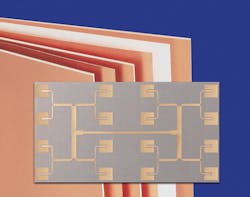This file type includes high resolution graphics and schematics when applicable.
Antennas are the seen and unseen components within every wireless communications link. Some populate large cellular towers on hillsides. Others receive and transmit signals within buildings as microcell printed-circuit-board (PCB) antennas. All require a careful blend of dielectric and conductor materials to minimize intermodulation and to give low-level wireless signals every chance of getting through.
For printed-circuit antenna designers seeking the lowest possible passive intermodulation (PIM) levels, that optimum blend of materials may just be found by way of the RO4730G3 94 V-0 antenna-grade laminates from Rogers Corp. Featuring a dielectric constant of 3.00 maintained to a tolerance of ±0.05 through the z axis (thickness) of the material, these laminates are capable of PIM levels of –160 dBc for almost negligible intermodulation distortion for 4G and 5G base transceiver stations (BTS) and microcells, as well as Internet of Things (IoT) wireless hubs.
The outstanding PIM performance was measured with two test tones of +43 dBm at 1.9 GHz for a 0.060-in.-thick laminate under test. RO4730G3 antenna-grade laminates (see figure) consist of ceramic hydrocarbon dielectric materials with low-profile LoPro copper foil to minimize PIM. Both the dielectric and conductor materials exhibit low-loss behavior. The laminates are 30% lighter than most polytetrafluoroethylene (PTFE) circuit materials traditionally used to achieve low-loss performance at microwave frequencies, assuming a comparison of materials of equal thickness.
Next-Gen Laminate
The antenna-grade RO4730G3 circuit materials are actually an evolution of Rogers’ RO4000 circuit materials. They combine ceramic hollow spheres and an organohalogen flame-retardant additive with low-loss, high-linearity LoPro copper conductor metal to achieve enhanced performance for antenna applications.
That combination improves the material’s rigidity over traditional PTFE laminates, enabling it to handle the conditions of automated-assembly manufacturing and lead-free-solder processes while being flame-retardant per Underwriters’ Laboratories (UL) requirements of UL 94 V-0. In addition, RO4730G3 materials have a glass transition temperature (Tg) of +280°C for compatibility with the higher melt temperatures of lead-free solders.
In terms of material characteristics, RO4730G3 laminates exhibit behavior well-suited to the requirements of present and emerging wireless-communications antennas. The dielectric constant (Dk) of 3.0 is measured in the z axis (thickness) at 10 GHz. The dielectric loss or dissipation factor (Df) in the z axis is quite low within the range of frequencies used for wireless communications—just 0.0023 at 2.5 GHz, rising to a still-low 0.0029 at 10 GHz.
In addition to impressive Dk tolerance of ±0.05 at room temperature, RO4730G3 material exhibits little change of Dk with temperature, as evidenced by a low thermal coefficient of dielectric constant of +26 ppm/°C in the z axis across a wide temperature range of –50 to +150°C. The circuit materials are formulated for high reliability over wide temperature extremes, as measured by coefficient of thermal expansion (CTE) that is relatively close to the 16.6 ppm/°C of copper.
RO4730G3 laminates exhibit a CTE of 13.7 ppm/°C in the x axis, 14.7 ppm/°C in the y axis, and 30.3 ppm/°C in the z axis, from –55 to +288°C. The z-axis value is of particular importance for multilayer designs and circuits with plated through holes (PTHs), so that copper and dielectric material exhibit similar changes with temperature.
Materials for the RO4730G3 represent a cost-effective alternative to PTFE materials for reliable, consistent, low-loss circuits with many of the characteristics sought by antenna designers. Whether for active antenna arrays in BTS infrastructure or microstrip PCB antennas in microcells, these materials provide high performance with ease of processing. On top of that, the Dk value is well within the range of circuit materials currently being used for wireless infrastructure antennas (typically 2.5 to 3.0).
Rogers Corp., Advanced Connectivity Solutions, 100 S. Roosevelt Ave., Chandler, AZ 85226-3416; (480) 961-1382
This file type includes high resolution graphics and schematics when applicable.
About the Author
Jack Browne
Technical Contributor
Jack Browne, Technical Contributor, has worked in technical publishing for over 30 years. He managed the content and production of three technical journals while at the American Institute of Physics, including Medical Physics and the Journal of Vacuum Science & Technology. He has been a Publisher and Editor for Penton Media, started the firm’s Wireless Symposium & Exhibition trade show in 1993, and currently serves as Technical Contributor for that company's Microwaves & RF magazine. Browne, who holds a BS in Mathematics from City College of New York and BA degrees in English and Philosophy from Fordham University, is a member of the IEEE.



